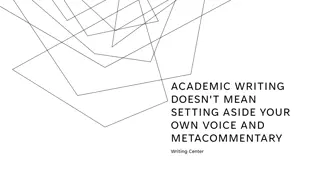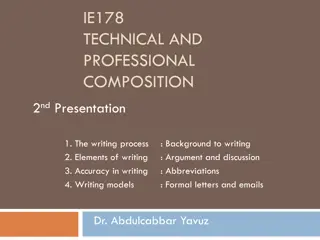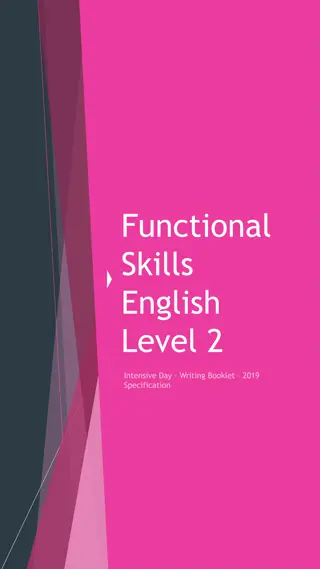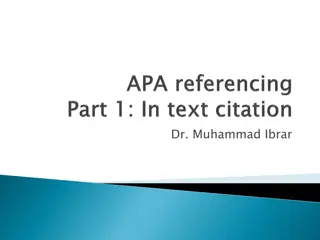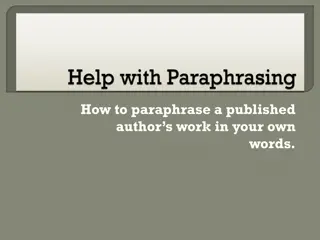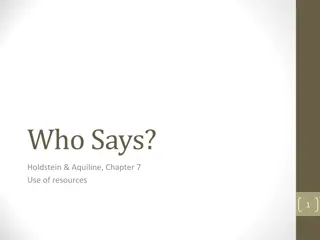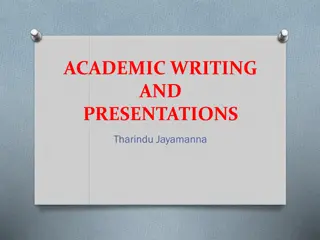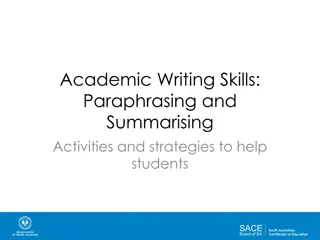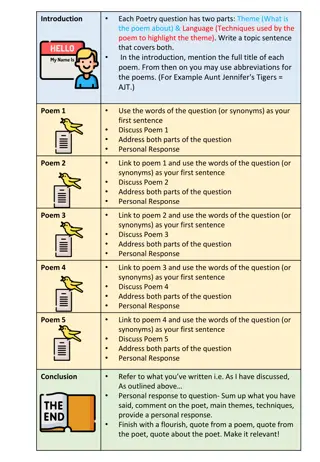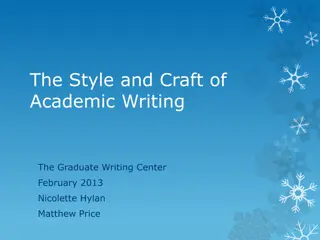Mastering Quoting Techniques in Academic Writing
Learn when to quote, summarize, use ellipses, brackets, and punctuate quotations effectively in academic writing. Explore examples and guidelines for maintaining accuracy and integrity while incorporating direct quotes and paraphrased content in your work.
Download Presentation

Please find below an Image/Link to download the presentation.
The content on the website is provided AS IS for your information and personal use only. It may not be sold, licensed, or shared on other websites without obtaining consent from the author.If you encounter any issues during the download, it is possible that the publisher has removed the file from their server.
You are allowed to download the files provided on this website for personal or commercial use, subject to the condition that they are used lawfully. All files are the property of their respective owners.
The content on the website is provided AS IS for your information and personal use only. It may not be sold, licensed, or shared on other websites without obtaining consent from the author.
E N D
Presentation Transcript
WHETHER TO QUOTE OR SUMMARIZE QUOTE TEXT WHEN: The wording is worth repeating (e.g. vivid or technical language) The author makes a point so well that no rewording will do it justice You want to cite the exact words of a known authority on a topic The author s opinions challenge or disagree with those of others
ELLIPSES Indicate any omissions from a quotation with an ellipsis (3 spaced dots). You may sometimes delete words from your quotation that are unnecessary for your point. Be careful not to distort the source s meaning.
EXAMPLES Mark Twain writes, I have never taken any exercise . . . and I never intend to take any. Sir William Osler states, A well-trained sensible family doctor is one of the most valuable assets in a community. . . . Few men live lives of more devoted self-sacrifice.
BRACKETS Indicate an addition or alteration to a quotation with brackets. Sometimes you ll need to change or add words in a quote to make the quote fit grammatically in you sentence.
EXAMPLES I tried to make the dish mild enough for everyone, but my idea of add[ing] Cayenne pepper to taste was not the same as my friend s idea. In Thomas Jefferson s time there was definitely a notion that a little rebellion now and then [was] a good thing.
Punctuating quotations Put periods and commas inside the quotation marks, except when you have a parenthetical citation at the end, in which case you put the period after the parentheses. Semicolons, colons, and dashes are generally placed outside the terminal quotation marks.
EXAMPLE Country music, Sam says, is a crucial and vital part of the American identity (23). George wrote that those who cannot remember the past are condemned to repeat it ; today, we are in danger of forgetting the lessons of history.
? & ! These go inside closing quotation marks if they are part of the quoted material but outside when they are not. If there s a parenthetical citation at the end, it immediately follows the closing quotation mark, and any punctuation that s part of your sentence comes after.
EXAMPLE Speaking at a Fourth of July celebration, Frederick Douglass asked, What have I, or those I represent, to do with your national independence? (34). Who can argue with W. Charisse Goodman s observation that media images persuade women that thinness equals happiness and fulfillment (43)?
Signal Phrases You need to introduce quotations and summaries clearly. Let the reader know who the author is and if need be something about his credentials. It makes clear that everything between the signal phrase and the citation comes from that source.
EXAMPLE Professor and textbook author Elaine Tyler May argues that many high school history books are too bland to interest young readers (531). A champion of civil liberties, Robert Ingersoll insists, I am the inferior of any man whose rights I trample underfoot.



